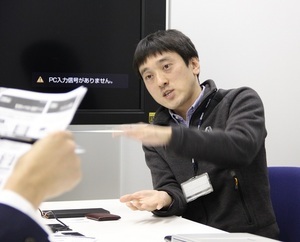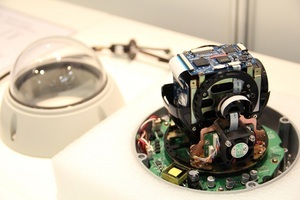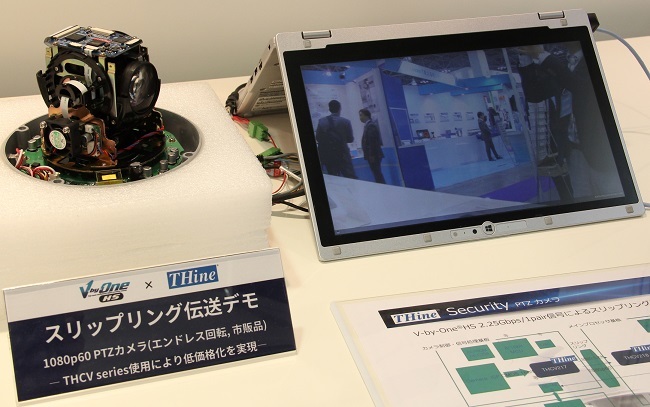THine Value Stable and low-cost data transmission for surveillance cameras via slip ring optimization
2015.06.04
- Article
- Solution
THine Electronics, Inc.’s Product Planning Dept. System Group Manager Hirotsugu Mikawa wants to solve the problems that designers at camera manufacturers face as they design surveillance cameras.
 THine Electronics is a global leader in the field of high-speed serial interface and image processing. We are now able to apply our proprietarily developed image transmission gigabit serial interface technology V-by-One® HS to the surveillance camera market, and achieve robust and low-cost slip ring transmission of HDTV and higher resolution image data within the surveillance camera.
THine Electronics is a global leader in the field of high-speed serial interface and image processing. We are now able to apply our proprietarily developed image transmission gigabit serial interface technology V-by-One® HS to the surveillance camera market, and achieve robust and low-cost slip ring transmission of HDTV and higher resolution image data within the surveillance camera. Here is the situation according to Mikawa. Up until now, surveillance cameras have been centered on analog transmission, but these days, with pan-tilt-zoom cameras (PTZ cameras), HDTV or 4K2K resolution network cameras have started to become used on a widespread basis. However, many designers have been letting us know about the technological and cost-related issues they face.
As Mikawa explains, with conventional technology, transmission of high-speed, high-resolution data such as HDTV or 4K2K results in severe slip ring signal deterioration and, as a result, it has been difficult to achieve stable and long-distance transmission. In addition, with the switch to digital, the number of cables has increased and costs have been on the rise.
Moreover, Mikawa clarified what prompted the company to promote V-by-One® HS technology to developers. He says, “When we thought about the developers of surveillance cameras as a target, we were able to assume that problems with transmission routes would emerge in conjunction with the advent of high-resolution surveillance cameras.”
The company then found a way to use V-by-One® HS technology, which was developed as a next-generation interface and which is used in flat panel TVs, multi-function printers (MFP), and other devices, and a new solution emerged.
However, adopting V-by-One® HS to the surveillance camera market was no simple task.
Mikawa explains that slip rings were not designed for high-speed transmission. Structurally, it is difficult to design slip rings that work well for high-speed transmission. Since it is tough to make a decision based on theory alone, a large volume of sample data were necessary. In order to create an excellent product for users, it was necessary to focus our energy on collecting sample data.
It would be meaningless if it was not convenient and user-friendly for surveillance camera developers, the target. We put V-by-One® HS through many tests to come up with a superbly functional product.
The great possibilities of high-speed digital transmission technology
So, what are the specific strengths of V-by-One® HS as a product?
 One feature of V-by-One® HS technology is that it has excellent high-speed signal transmission quality, and allows for a reduction in cables and enables longer transmission of data. Even in environments where there is signal deterioration of the slip ring, which is the rotating connector component, stable transmission of high-speed, high-resolution data is made possible. Also, compared with LVDS transmission, V-by-One® HS transmission requires only one-fourth the number of slip ring cores, which marks a major reduction.
One feature of V-by-One® HS technology is that it has excellent high-speed signal transmission quality, and allows for a reduction in cables and enables longer transmission of data. Even in environments where there is signal deterioration of the slip ring, which is the rotating connector component, stable transmission of high-speed, high-resolution data is made possible. Also, compared with LVDS transmission, V-by-One® HS transmission requires only one-fourth the number of slip ring cores, which marks a major reduction.
*Slip ring core reduction in 1080p60 signal: 8pair(LVDS)→2pair(V-by-One ®HS)
In addition, V-by-One® HS costs less than previous technologies, and it should be noted that this high-speed interface technology proprietarily developed by THine Electronics has become the de facto standard for internal high-speed interface for 4K and other high-resolution TVs.
 One feature of V-by-One® HS technology is that it has excellent high-speed signal transmission quality, and allows for a reduction in cables and enables longer transmission of data. Even in environments where there is signal deterioration of the slip ring, which is the rotating connector component, stable transmission of high-speed, high-resolution data is made possible. Also, compared with LVDS transmission, V-by-One® HS transmission requires only one-fourth the number of slip ring cores, which marks a major reduction.
One feature of V-by-One® HS technology is that it has excellent high-speed signal transmission quality, and allows for a reduction in cables and enables longer transmission of data. Even in environments where there is signal deterioration of the slip ring, which is the rotating connector component, stable transmission of high-speed, high-resolution data is made possible. Also, compared with LVDS transmission, V-by-One® HS transmission requires only one-fourth the number of slip ring cores, which marks a major reduction. *Slip ring core reduction in 1080p60 signal: 8pair(LVDS)→2pair(V-by-One ®HS)
In addition, V-by-One® HS costs less than previous technologies, and it should be noted that this high-speed interface technology proprietarily developed by THine Electronics has become the de facto standard for internal high-speed interface for 4K and other high-resolution TVs.
Learn more about V-by-One® HS
 Sunho Hwang of the Sales Department says that the product has already built up a track record overseas, and that THine is now working to get people to understand the product’s strengths. Therefore, the next challenge for THine is how to accurately let camera manufacturer designers know how it can work for them.
Sunho Hwang of the Sales Department says that the product has already built up a track record overseas, and that THine is now working to get people to understand the product’s strengths. Therefore, the next challenge for THine is how to accurately let camera manufacturer designers know how it can work for them. One of the reasons we exhibited the product at the SECURITY SHOW 2015 held at Tokyo Big Sight was to have attendees learn about these features of V-by-One® HS in a real-life setting.
Through a real demo of an endless rotary camera compatible with 1080p60, as well as V-by-One® HS optical data communications, which are new solutions in the surveillance camera industry, Hwang wants to have manufacturers realize that THine is offering solutions in their field and that this is a technology that can be applied to surveillance cameras.
V-by-One® HS has enabled solution for high-resolution and low-cost long-distance transmission to provide value-added to the surveillance camera market. THine’s engineers will continue their quest to further evolve transmission technology.
